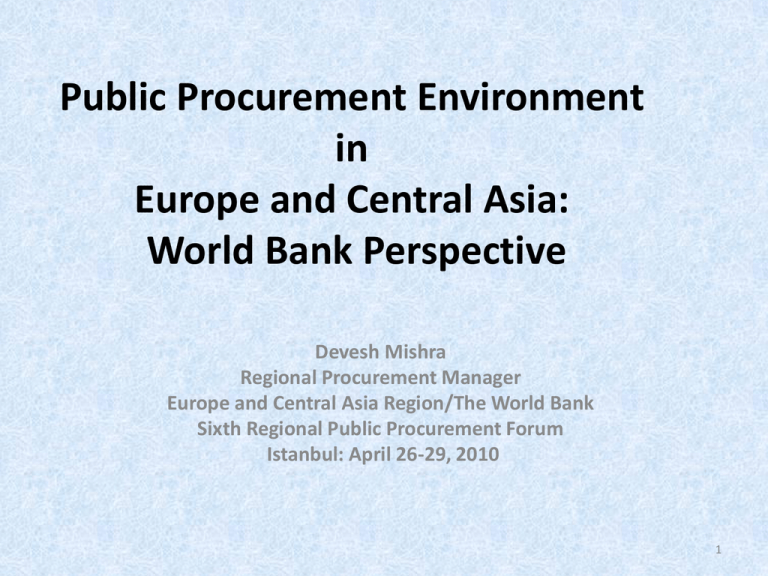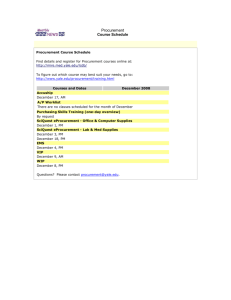Public Procurement Trends in Europe and Central Asia World Bank's
advertisement

Public Procurement Environment in Europe and Central Asia: World Bank Perspective Devesh Mishra Regional Procurement Manager Europe and Central Asia Region/The World Bank Sixth Regional Public Procurement Forum Istanbul: April 26-29, 2010 1 Content Background Bank’s involvement Recent Developments Central and Eastern European Countries/Issues with Procurement Harmonization with EC South Eastern European Countries ( Balkans) Turkey Ukraine, Moldova, Belarus Russia Armenia, Azerbaijan, Georgia (Caucasus) Central Asian Countries Quick Lessons from Use Of Country System Pilot Way Forward 2 Background • Establishment of new independent countries and introduction to market economy after collapse of Soviet Union • Introduction of new public procurement laws, mostly based on UNCITRAL Model Law (1994): Revision expected in 2010/2011 • WTO – Government Procurement Agreement (1996) • European Directives on Public Procurement (2004) • World Bank working closely with other international institutions (EC, EBRD/ EIB, IsDB, ADB) in the area of public procurement reforms to approach their common client countries with the same voice 3 Bank’s Involvement 1. 2. Key priority for the Bank is to improve country public procurement systems for a real impact in the countries. Maintaining continuous dialogue with the countries on public procurement i. ii. iii. iv. 3. 4. 5. Conducting diagnostic work (CPARs, Joint Fiduciary Assessments, PEFA), Providing technical assistance through IDF Grants Examples: Armenia, Moldova, Kyrgyz, Azerbaijan, Turkey , Georgia etc Reviewing and providing comments on draft public procurement legislation (PPLs, SBDs and Manuals) Introducing policy actions through DPLs / PRSCs, Capacity building and institutional strengthening in countries Moving forward with the use of country systems in procurement, conducting assessments in line with the Board Paper on Use of Country System(UCS) Collaborating with other donors and international institutions. 4 Central and Eastern European Countries (Romania, Bulgaria, Croatia, Poland, Latvia, Lithuania, Slovenia, Czech Republic, Estonia, Hungary, Slovak Republic) a) b) c) d) e) f) First public procurement laws based on UNCITRAL Model Law in mid 1990s EU Accession was the main driving force for all of these countries to improve their legislation and adopt modern public procurement laws New public procurement laws in 2000s with several amendments to ensure full compliance with EC Directives WB, EBRD, EIB, EC supported the public procurement reform through technical assistance, grants and several diagnostic studies. Poland: New Law in 2009: One of the pilot country for Use of Country System Modernization through e-procurement. 5 Key Issues in Procurement Harmonization with the European Union 1. 2. 3. Eligibility: – WB: No restriction based on nationality – EU: Directives are silent on eligibility.(54 countries are directly or indirectly concerned by EU procurement Framework) – Solution: Will be dealt on a case by case when they arise( if there is restriction to access the complaint system by foreign firms) Use of procurement methods (Open Competitive Bidding vs Restrictive Procedure): – WB: LIB is used only under certain conditions. – EU: Both can be used. Open procedure not the default method. RP may limit the number of bidders. – Solution: Under RP all qualified bidders shall be invited. Evaluation of Bids: – WB: Award to the lowest evaluated substantially responsive bidder, no merit point evaluation, bid evaluation by excluding import duty and taxes. – EU: Use of price and non-price criteria in evaluation, bid evaluation by including all taxes and duties. – Solution: Evaluation criteria should be objective and disclosed in the procurement notice and bidding documents, EU import duties and taxes are low and have negligible effect on bid evaluation. WB will only finance such a contract if a ranking of an non-EU bidder is not negatively effected by inclusion of duties. 6 Key Issues in Procurement Harmonization with the European Union(contd.) 4. Procurement Procedures for Consulting Services: – WB: Separate methods for consulting services. – EU: Same three methods (Open, Restricted and Negotiated Procedures) apply. – Solution: Restricted Procedure can be adopted for the use of consultant selection similar to QCBS. 5.Two-Stage Bidding vs Competitive Dialogue: These are similar but different in approach. 6. Negotiated Procedure: – WB: Negotiations are not permitted, except under certain circumstances. – EU: Negotiations are permitted simultaneously with two or more bidders. – Solution: Will be dealt on a case by case basis. 7 South Eastern European Countries / Balkans (Albania, FYR Macedonia, Serbia, Bosnia, Kosovo, Montenegro) a. b. c. d. e. f. g. First public procurement laws based on UNCITRAL Model Law in late 1990s or early 2000s EU Accession is a very important incentive for all of these countries to improve their legislation and align with EC Directives. Even though there are several improvements, many challenges still remain. New public procurement laws are dated late 2000s and few of these are mostly in compliance with EC Directives, though implementation issues remains due to inadequate capacity Albania: First country in the region to carry out OECD-DAC benchmarking in 2006 and has implemented several procurement reforms FYR Macedonia: PPL aligned with EC Directives. One of the Countries as pilot for Use of Country System Kosovo: Bank conducted an Operations Procurement Review in 2004 and worked on improving the PPL with the government WB, EBRD, EIB, EC supported the public procurement reform through technical assistance, grants and several diagnostic studies. 8 Turkey a. b. c. d. e. f. g. h. i. j. Old public procurement law dated 1983 CPAR (2001) was very timely and recommendations were taken seriously New public procurement law dated 2002 Public procurement reform implementation support through IDF Grant (2002 – 2005) Series of amendments to make the law in line with EC Directives are done, but more needs to be done for full compliance Regulatory Agency – Public Procurement Agency Independent Complaint Review Body – Public Procurement Agency WB, EC supporting the public procurement reform through technical assistance, grants and several diagnostic studies Has done pioneering work in public procurement to be used as a model for the entire region Was “pilot” of pilot for Use of Country System in Bank-funded operations in 2008 9 III. Ukraine, Moldova, Belarus a. First public procurement laws based on UNCITRAL Model Law in early 2000s b. First generation CPARs are prepared in early 2000s and second generation CPARs are being conducted by incorporating OECD/DAC methodology for assessment of National Procurement Systems in late 2000s c. Several IDF Grants to support the public procurement reform agenda d. Current public procurement laws dated late 2000s e. Ukraine: revising again its PPL- WB/EC engaged f. Moldova: CPAR 2010 being done using OECD-DAC benchmarking g. Belarus: Presidential decree on supplies of goods for state needs. Draft PPL. 10 Russian Federation a. New public procurement law dated 2005. b. While there are several improvements in the public procurement area, there are many deficiencies and negative aspects of the laws yet to be addressed. c. WB, EBRD, EIB, EC supporting the public procurement reform through technical assistance, grants and several diagnostic studies. 11 Caucasus (Azerbaijan, Armenia, Georgia) a. First public procurement laws based on UNCITRAL Model Law in early 2000s b. First generation CPARs in early 2000s and second generation CPARs incorporating OECD/DAC methodology for assessment of National Procurement Systems in late 2000s c. Several IDF Grants to support the public procurement reform agenda d. Current public procurement laws dated late 2000s e. Bank has recently carried out CPAR for all the three countries using OECD-DAC Benchmarking tool f. In active dialogue with the government to implement CPAR recommendations. 12 Central Asian Countries (Kazakhstan, Kyrgyz Republic, Turkmenistan, Tajikistan, Uzbekistan) a. First public procurement laws in late 1990s b. First generation CPARs in early 2000s and second generation CPARs incorporating OECD/DAC methodology for assessment of National Procurement Systems in late 2000s c. Current public procurement laws dated late 2000s and mostly in line with internationally accepted standards, but still some countries do not have any public procurement law at all d. Weak capacity and widespread implementation issues exist 13 Central Asian Countries (Kazakhstan, Kyrgyz Republic, Turkmenistan, Tajikistan, Uzbekistan ) • Kazakhstan: Hosted 2006 Central Asia Public Procurement Forum, Bank carried out limited assessment in 2005, OECDDAC Benchmarking likely in 2011 • Kyrgyz Republic: Hosted 2007 and 2009 Forum, IDF Grant, CPAR 2007. Reorganization of public procurement agency • Turkmenistan: No PPL, IDF grant in 1996.More work needed • Tajikistan: Hosted 2008 Forum, CPAR 2003 • Uzbekistan: No PPL, Multiple bodies on public procurement control, issues of import contract, Country Fiduciary Assessment 2010 in progress. 14 Quick Lessons from Use of Country System Pilot • Need to develop capacity of procurement officials to implement in accordance with the laws and regulations • Weak complaint handling mechanisms • Lack of full range of model bidding documents and general conditions of contracts but most countries do have documents for goods and works • Lack of generic users’ guide • Handling of selection of consultants differs from Bank’s Guidelines • Dispute resolution procedures do not use arbitration • Lack of information on enforcement of dispute resolution decisions or compliance with the PPL • Procurement is not seen as a profession 15 Way Forward • What are the common lessons from the experience of ECA Client countries ? • Lessons from UCS pilots? • How different funding agencies and client countries work together to improve the public procurement system in ECA region? • How to we make our sharing knowledge sustainable, more effective and actionable? 16








